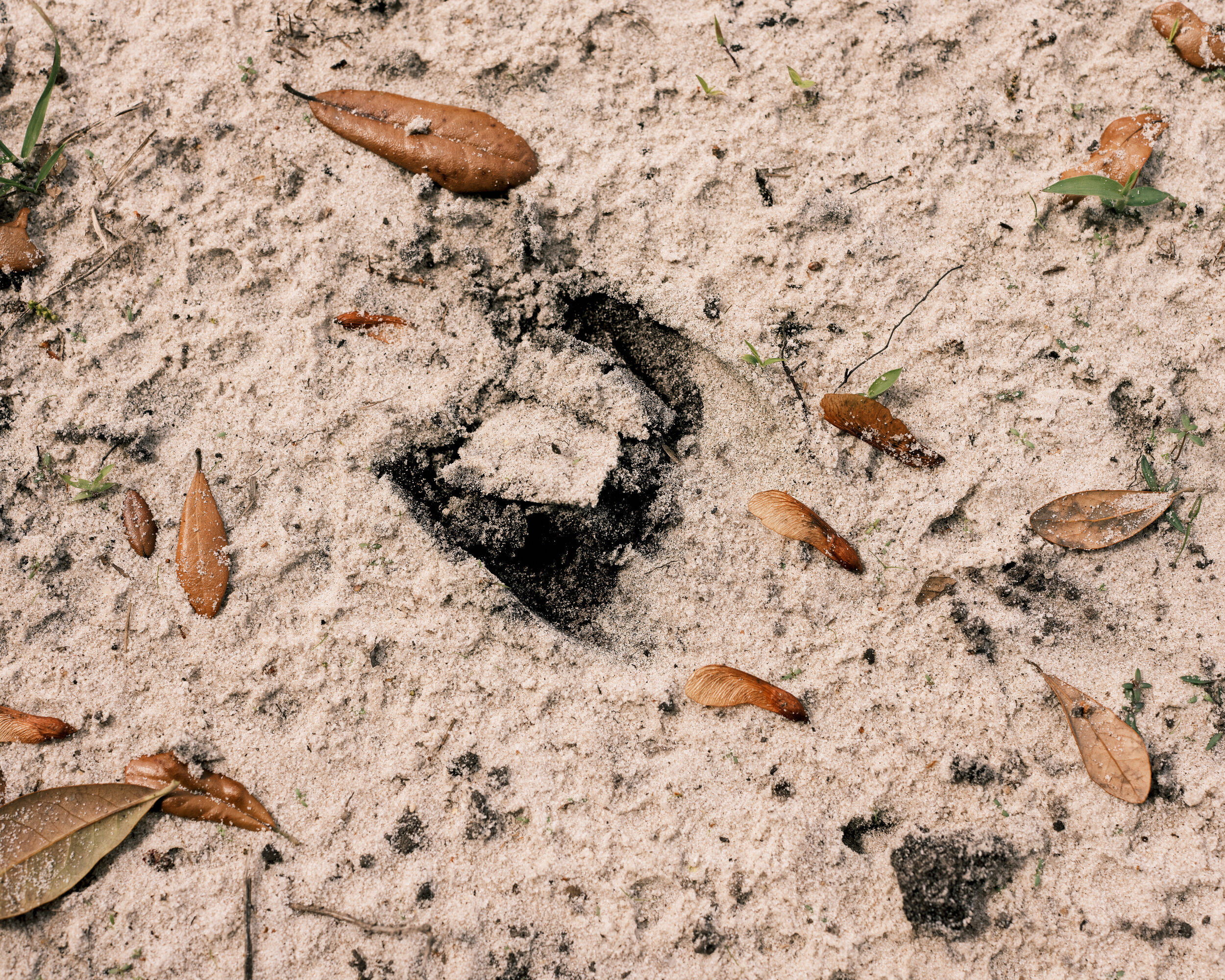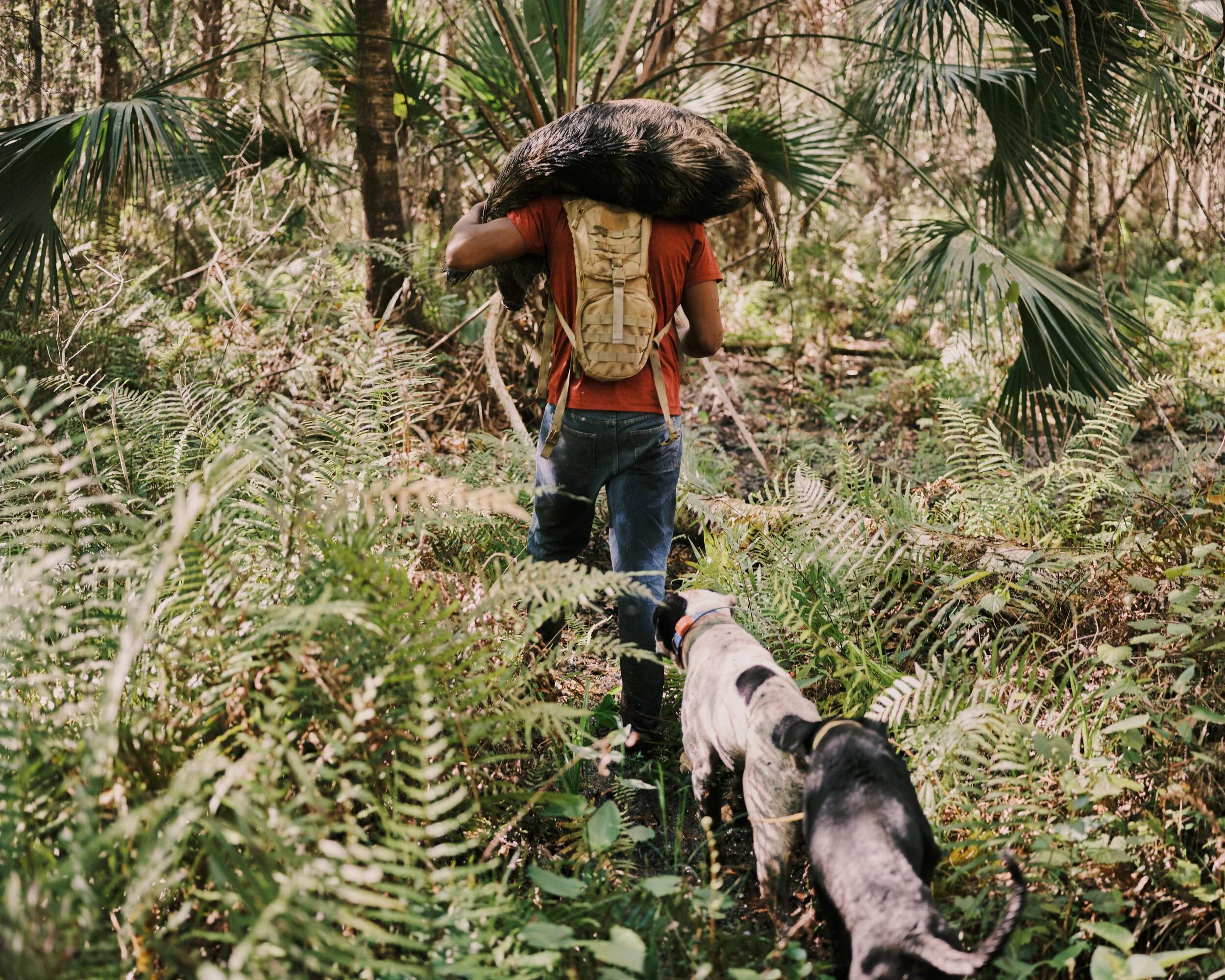the war on hogs
Quotations from the story by Jordan Blumetti for The Guardian, assigned by photo editor Jehan Jilani.
Pompi Rodriguez hunts feral hogs.
“Driving through a wooded retirement burg 30 miles south of Orlando, he makes a sharp turn off-road on to a dirt trail, and parks on a small mound in view of a cypress dome. He points out a series of depressions in the earth. “Those are hog wallows,” he says. “Look at how big they are.” The troughs are about the size of bathtubs with a cloud of flies hovering above, indicating they’re fresh, from the last couple of hours.”
Pompi Rodriguez uses trained dogs to hunt feral hogs.
“Pompi, 26, unlatches the tailgate and opens the crates bolted to his truck bed, releasing four hunting dogs that run hell-for-leather into the marsh, disappearing behind a low curtain of palmetto trees. Barking erupts in a warped echo. “That’s our hog,” he says. “Bubba jumped him.”
Pompi Rodriguez takes a smoke break while fixing his truck after he broke down on 4 March 2021 in Poinciana, Florida.
Pompi’s dogs scour suburban backyards for any trace of hogs. Neighborhood officials will often hire Pompi to take care of problem hogs, which ravage property in swampy suburbia.
“Upwards of 9 million wild boar roam 39 states across the US, which is up from an estimated 2 million in 17 states three decades ago. Florida hosts more than half a million – the second largest population of hogs in the country behind Texas, but also the oldest bloodline. The first pigs to arrive in America were brought by the Spanish explorer Hernando de Soto, who landed near present-day Tampa in 1539. They promptly escaped, establishing a critical mass of the now-ubiquitous vermin.
Today, wild hogs are considered the most destructive invasive species in the country, and the greatest wildlife challenge that the US faces in the 21st century. According to US Department of Agriculture estimates, they cause north of $2.5bn in damage each year. With gnarled tusks and bodies that can swell to the size of oak bourbon barrels, they trash watersheds, destroy crops, attack livestock, spread disease, terrorize residents and desecrate archeological sites; they are aggressive, whip-smart, lightning-fast and dine opportunistically on oak berries, trash, corn, carrion and each other. A passel of hogs can take out a commercial watermelon or tomato farm overnight, leaving the fields resembling a blast site from a hail of mortar shells.”
“Florida’s plight is especially severe because the state’s current housing boom is rapidly turning the once rural stretches between Tampa and Orlando into a single conurbation. The same goes for the creeping inland sprawl in the rest of the state: wetlands, pine forests and vestigial orange groves that were recently hog habitats have become densely populated housing developments, strings of red-roofed tract homes and retirement communities. The majority of Florida’s new exurban residents, seniors in particular, are living closer to hogs than ever before.”
“The hog issue is not thought of as a solvable problem, but one that could only be attenuated. Although trapping – after which they are sterilized, killed, sold for hunting or released elsewhere – is the most common form of hog mitigation, the traps themselves are often ineffectual. The creatures are smart enough to eat every kernel of corn inside a box trap except the one that trips the trigger.
‘I’ve probably trapped close to 10,000 hogs,’ Pompi shouts from underneath the hood of his truck. He’s changing a spark plug at his neighborhood mechanic shop. “They’ll call me and say they need 20 hogs in two days, and I run all over the state to catch them,” he says, referring to the buyers who purchase hogs to stock their hunting ranches.
“I’m an outlaw.”
“Pompi means he’s a poacher, which is a grave offense in Florida – unless you are poaching hogs. He says most landowners and law enforcement turn a blind eye. It’s considered a public service.
Pompi and the dogs trudge through knee-high swamp muck, thick brambles and crawl through barbed wire fences to find the unsuspecting hogs.
A scar from a boar’s tusk on Pompi’s arm.
A fresh hog track in the soft sand around a watering hole.
The dogs spread out in search of hogs, often disappearing from sight for 15 minutes or more. Pompi uses a GPS device and tracking collars to watch their movements. The collars will alert Pompi when they have cornered, or “treed” a hog by detecting the hogs squeals on imbedded microphones in the collars.
We have been walking through the wilderness for several hours. We watched the dogs on the GPS as they chased a hog for 1300 meters through thick brush and swamp, to no avail. We are running low on water and daylight. We are ready to go home empty handed. We hear a scream.
Pompi pauses and takes off running. I try to keep up. I do not fall. I do not ruin my camera gear in the deep muck. The squeals permeate the dense landscape.
I push through the brambles. I see Pompi smiling.
The dogs have caught an 80 pound female. A mother.
They hold the sow by the neck and ears as it tries to escape. Pompi grabs her hindquarters.
Pompi flips the sow on her back. The dogs do not let go. Their instincts are strong. The hog must be taken out alive.
The dogs release after some coaxing. The hog is exhausted and bleeding.
I see the sows eyes for the first time. I think of the animals I love. I try to remember she is invasive, destructive. I wonder about her piglets. I try to focus on the numbers.
Pompi is pleased. The dogs are pleased. I am focused. The sow struggles and sighs under the weight of Pompi’s knee.
He pulls out some rope. He binds her hooves together. He is nimble. I assume this is what hog-tying is.
Pompi hefts the 80-pound sow onto his shoulder. He is proud. The mother gnashes her teeth.
We begin the two mile walk back to the truck. The dogs follow closely, impatiently.
We push through the same path we entered from. Pompi knows the way intrinsically. We walk through a backyard with a play structure, back into suburbia. Pompi drops the hog on his truck bed. He unties her next to a mailbox. The evening sun flares. The mother is resigned.

































